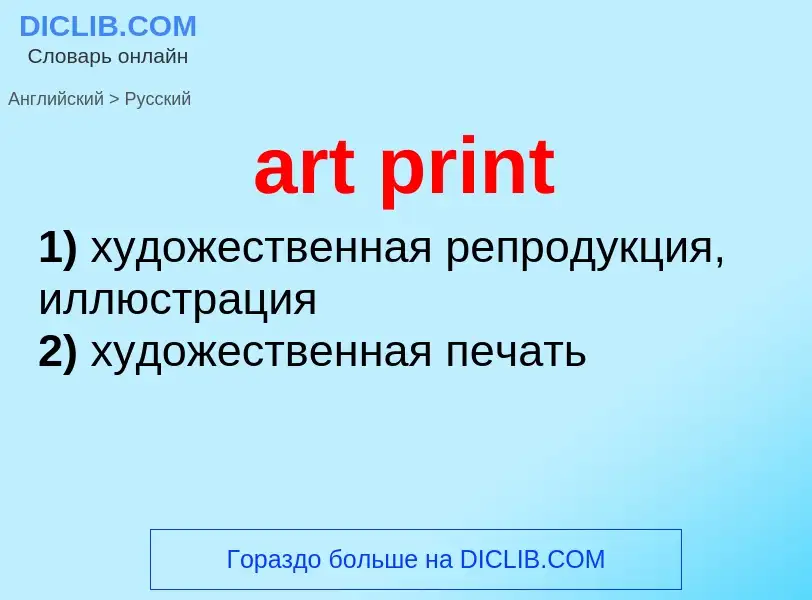Перевод и анализ слов искусственным интеллектом ChatGPT
На этой странице Вы можете получить подробный анализ слова или словосочетания, произведенный с помощью лучшей на сегодняшний день технологии искусственного интеллекта:
- как употребляется слово
- частота употребления
- используется оно чаще в устной или письменной речи
- варианты перевода слова
- примеры употребления (несколько фраз с переводом)
- этимология
art print - перевод на русский
['printmeikə]
существительное
искусство
художник-гравёр
автор гравюр
эстампов
Википедия

Printmaking is the process of creating artworks by printing, normally on paper, but also on fabric, wood, metal, and other surfaces. "Traditional printmaking" normally covers only the process of creating prints using a hand processed technique, rather than a photographic reproduction of a visual artwork which would be printed using an electronic machine (a printer); however, there is some cross-over between traditional and digital printmaking, including risograph.
Prints are created by transferring ink from a matrix to a sheet of paper or other material, by a variety of techniques. Common types of matrices include: metal plates for engraving, etching and related intaglio printing techniques; stone, aluminum, or polymer for lithography; blocks of wood for woodcuts and wood engravings; and linoleum for linocuts. Screens made of silk or synthetic fabrics are used for the screen printing process. Other types of matrix substrates and related processes are discussed below.
Except in the case of monotyping, all printmaking processes have the capacity to produce identical multiples of the same artwork, which is called a print. Each print produced is considered an "original" work of art, and is correctly referred to as an "impression", not a "copy" (that means a different print copying the first, common in early printmaking). However, impressions can vary considerably, whether intentionally or not. Master printmakers are technicians who are capable of printing identical "impressions" by hand. A print that copies another work of art, especially a painting, is known as a "reproductive print".
Multiple impressions printed from the same matrix form an edition. Since the late 19th century, artists have generally signed individual impressions from an edition and often number the impressions to form a limited edition; the matrix is then destroyed so that no more prints can be produced. Prints may also be printed in book form, such as illustrated books or artist's books.



![[[Monotype]] by the technique's inventor, [[Giovanni Benedetto Castiglione]], ''The Creation of Adam'', c 1642 [[Monotype]] by the technique's inventor, [[Giovanni Benedetto Castiglione]], ''The Creation of Adam'', c 1642](https://commons.wikimedia.org/wiki/Special:FilePath/Giovanni Benedetto Castiglione - The Creation of Adam - Google Art Project.jpg?width=200)

.jpg?width=200)
![Otto Müller]]'', 1915 Otto Müller]]'', 1915](https://commons.wikimedia.org/wiki/Special:FilePath/Kirchner - Bildnis Otto Mueller.jpg?width=200)
![''[[Melencolia I]]'', 1514 engraving by [[Albrecht Dürer]], one of the most important printmakers. ''[[Melencolia I]]'', 1514 engraving by [[Albrecht Dürer]], one of the most important printmakers.](https://commons.wikimedia.org/wiki/Special:FilePath/Melencolia I (Durero).jpg?width=200)
![[[Hiroshige]], ''Morning Mist'' [[Hiroshige]], ''Morning Mist''](https://commons.wikimedia.org/wiki/Special:FilePath/Mishima Asa-Giri-東海道五十三次之内 三島 朝霧-Morning Mist MET DP123235.jpg?width=200)
![The National Gallery of Art]], Washington, D.C. The National Gallery of Art]], Washington, D.C.](https://commons.wikimedia.org/wiki/Special:FilePath/Paul Gauguin, Arearea no Varua Ino (Words of the Devil) (recto), 1894, NGA 11586.jpg?width=200)
![The National Gallery of Art]], Washington, D.C. The National Gallery of Art]], Washington, D.C.](https://commons.wikimedia.org/wiki/Special:FilePath/Rachael Robinson Elmer, Woolworth Building June Night, 1916, NGA 147751.jpg?width=200)

![''[[The Three Crosses]]'', 1653 [[drypoint]] by [[Rembrandt]] ''[[The Three Crosses]]'', 1653 [[drypoint]] by [[Rembrandt]]](https://commons.wikimedia.org/wiki/Special:FilePath/Rembrandt The Three Crosses 1653.jpg?width=200)
.jpg?width=200)

![''[[La Goulue]]'', Lithograph poster by [[Toulouse-Lautrec]] (1891) ''[[La Goulue]]'', Lithograph poster by [[Toulouse-Lautrec]] (1891)](https://commons.wikimedia.org/wiki/Special:FilePath/Toulouse-Lautrec - Moulin Rouge - La Goulue.jpg?width=200)
![[[Félix Vallotton]], ''La raison probante (The Cogent Reason)'', [[woodcut]] from the series ''Intimités'', (1898) [[Félix Vallotton]], ''La raison probante (The Cogent Reason)'', [[woodcut]] from the series ''Intimités'', (1898)](https://commons.wikimedia.org/wiki/Special:FilePath/Vallotton-Raison.gif?width=200)
